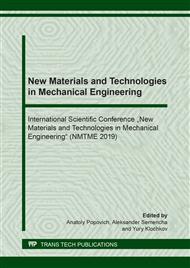[1]
Layus, P. (2017). USABILITY OF THE SUBMERGED ARC WELDING (SAW) PROCESS FOR THICK HIGH STRENGTH STEEL PLATES FOR ARCTIC SHIPBUILDING APPLICATIONS. Ph.D. Lappeenrannan teknillinen yliopisto.
Google Scholar
[2]
Márquez F. P. G. et al. Identification of critical components of wind turbines using FTA over the time //Renewable Energy. – 2016. – Т. 87. – С. 869-883.
DOI: 10.1016/j.renene.2015.09.038
Google Scholar
[3]
Bai X. et al. Modelling fatigue degradation of the compressive zone of concrete in onshore wind turbine foundations //Construction and Building Materials. – 2017. – Т. 132. – С. 425-437.
DOI: 10.1016/j.conbuildmat.2016.12.026
Google Scholar
[4]
Dilley L. M., Hulse L. Foundation design of wind turbines in Southwestern Alaska, a case study. – (2007).
Google Scholar
[5]
Majorowicz J. A., Skinner W. R., Šafanda J. Large ground warming in the Canadian Arctic inferred from inversions of temperature logs //Earth and Planetary Science Letters. – 2004. – Т. 221. – №. 1-4. – С. 15-25.
DOI: 10.1016/s0012-821x(04)00106-2
Google Scholar
[6]
Moriarty, P., Safety‐factor calibration for wind turbine extreme loads //Wind Energ., - 2008 - 11: 601-612.
DOI: 10.1002/we.306
Google Scholar
[7]
Negm H. M., Maalawi K. Y. Structural design optimization of wind turbine towers //Computers & Structures. – 2000. – Т. 74. – №. 6. – С. 649-666.
DOI: 10.1016/s0045-7949(99)00079-6
Google Scholar
[8]
International Electrotechnical Comission (IEC) IEC 61400-4:2012 Wind turbines -- Part 4: Design requirements for wind turbine gearboxes.
Google Scholar
[9]
Gosudarstvennyy Standart, (GOST) (1969). GOST 15150 Machines, instruments and other industrial products. Modifications for different climatic regions. Categories, operating, storage and transportation conditions as to environment climatic aspects influence.
Google Scholar
[10]
American Wind Energy Association (AWEA) (2015) AWEA 61400 – 1 Renewable power engineering. Wind power engineering. Wind turbines. Part 1. Technical requirements.
Google Scholar
[11]
American Wind Energy Association (AWEA) (2015) AWEA 61400 – 13 Measurement of Mechanical Loads.
Google Scholar
[12]
Dana, S., Van Dam, J.J. and Damiani, R.R., 2018. Validation of Simplified Load Equations Through Loads Measurement and Modeling of a Small Horizontal-Axis Wind Turbine Tower (No. NREL/TP-5000-67562). National Renewable Energy Lab.(NREL), Golden, CO (United States).
DOI: 10.2172/1435409
Google Scholar
[13]
International Organization for Standardization, (ISO) (2015) ISO 29400:2015 Ships and marine technology -- Offshore wind energy -- Port and marine operation., pp.27-30.
Google Scholar
[14]
Jiao, Z. and Jiang, C. (2011). Properties and Safety Management about LNG Carrier. Applied Mechanics and Materials, 99-100 (www.intetech. com/images/downloads/Paper57.pdf.), pp.934-938.
DOI: 10.4028/www.scientific.net/amm.99-100.934
Google Scholar
[15]
ASTM А353/А353М/ Standard Specific cation for Pressure Vessel Plates, Alloy Steel, Double-Normalized and Tempered 9% Ni // STANDARD by ASTM International. — [S. I.], 2014., p.13.
Google Scholar
[16]
ASTM А553/А553М/ Standard Specific cation for Pressure Vessel Plates? Alloy Steel Quenched and Tempered 7, 8 and 9% Ni // STANDARD by ASTM International. — [S. I.], 2014., p.17.
Google Scholar
[17]
Gosudarstvennyy Standart (GOST) (1999) GOST 2318-99 Building steel structures. General specifications, pp.20-25.
Google Scholar
[18]
International Organization for Standardization, (ISO) (2017) ISO 20273:2017 Guidelines on weld quality in relationship to fatigue strength. pp.31-33.
Google Scholar


